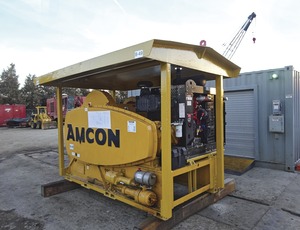


Fleet owners are struggling with new federal emission rules effective this year for off-road diesel-powered trucks and machines. The U.S. Environmental Protection Agency's Tier 4 Final standard cuts particulate matter (PM) and nitrogen oxide (NOx) emissions by 90%.
It marks the culmination of a multi-tiered emission reduction process started in 1996. Off-road diesel emissions are responsible for 15,000 heart attacks annually, the EPA claims, plus 12,000 premature deaths and 1 million lost work days each year. Manufacturers have since responded with two primary technologies: cooled exhaust gas recirculation (CEGR) or selective catalytic reduction (SCR). Both options mean added equipment and maintenance as well as greater costs and potential warranty woes.
SCR reduces particulate matter through higher combustion temperatures—foregoing a particulate filter—while using a urea-based diesel exhaust fluid (DEF) after-treatment for fewer nitrogen oxides. CEGR cools exhaust gases by mixing with fresh air before recirculating for reduced nitrogen oxides, though a diesel particulate filter (DPF) is still needed to collect soot. Tier IV program benefits outweigh added costs by a 40:1 ratio, the EPA claims, but industry experts say otherwise.
Tier 4 Final machines can cost up to 25% more than their predecessors, says Mundelein, Ill.-based equipment analyst Frank Manfredi, because of added hardware consisting of sensors and actuators, plus additional engineering, design complexity and engine packaging.
They can be more finicky, too, with greater sensitivity to water, dust and extreme temperatures. Tier IV systems can require low-ash engine oil, ultra-low sulfur diesel and additional fuel filtration for proper operation and upkeep. General Motors, for example, requires manufacturer-branded DEF-use on trucks for valid warranty claims, which could become a widespread future practice with other equipment makers, fears one industry expert.
"EGR and a DPF significantly increase demands on lube oil performance," says Peter Robson, product marketing director with Komatsu America Corp., Rolling Meadows, Ill. "Tier 4 specific engine oils are formulated to deal with these higher soot loadings and prevent premature engine wear."
Education poses a big challenge for fleet owners grappling with the new mandates, as operators, supervisors and mechanics learn the intricacies of Tier IV Final equipment and its accompanying alphabet soup of technologies: DPF, SCR, CEGR and DEF.
"It's another complete system that needs maintenance and requires training," says Thad Pirtle, equipment manager for Traylor Bros. Inc., Evansville, Ind., who oversees a fleet of 3,000 trucks and machines. "There is very little Tier IV Final stuff out there yet, so the added costs for maintenance and training are still unknown."
Many companies are self-developing Tier IV training programs, including Sunbelt Rentals Inc., Fort Mill, S.C., the country's second-largest construction equipment rental company with $1.5 billion in rental revenue across 376 outlets in 2012, according to industry trade publication Rental Equipment Register.
"We have been developing an internal Tier IV education for a long time," says Sunbelt fleet sourcing and support director Brad Coverdale, who oversees 50,000 pieces of diesel-powered machinery.
"It's a huge challenge that we are still navigating. We are using lectures, videos, demonstrations and pamphlets to educate our 5,000 employees, who, in turn, will share it with their customers," Coverdale says.
Other fleet owners, meanwhile, outsource training needs to firms like EMI-Global, which has developed a "triage" program addressing Tier IV issues, including diagnostics, service and repair.
The Littleton, Colo.-based consulting firm additionally installs automatic cutoff switches for Tier IV machinery for proper fluid control. However, a long learning curve looms as users, owners and manufacturers get their arms around Tier IV.
"Once this technology comes off warranty, you're on your own," says Richard LeFrancois, president at EMI-Global. "OEMs [original equipment manufacturers] haven't invested a lot of time or money on [Tier IV education] since it was government mandated. It resulted in a sophisticated technology being developed in a short time frame with limited testing. Ultimately, it's going to impact the end product."

Post a comment to this article
Report Abusive Comment